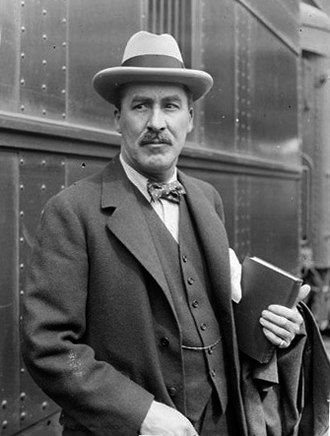Howard Carter

Howard Carter (9 May 1874 – 2 March 1939) was an English archaeologist and Egyptologist. He became world-famous after discovering the intact tomb of the 18th Dynasty Pharaoh, Tutankhamun in November 1922, the best-preserved pharaonic tomb ever found in the Valley of the Kings.
Howard Carter was born in Kensington on 9 May 1874, the youngest child (of eleven) of artist and illustrator Samuel John Carter and Martha Joyce (née Sands). His father helped train and develop his artistic talents.[1]
Carter spent much of his childhood with relatives in the Norfolk market town of Swaffham, the birthplace of both his parents.[2][3] Receiving only limited formal education at Swaffham, he showed talent as an artist. The nearby mansion of the Amherst family, Didlington Hall, contained a sizable collection of Egyptian antiques, which sparked Carter’s interest in that subject. Lady Amherst was impressed by his artistic skills, and in 1891 she prompted the Egypt Exploration Fund (EEF) to send Carter to assist an Amherst family friend, Percy Newberry, in the excavation and recording of Middle Kingdom tombs at Beni Hasan.[4]
Although only 17, Carter was innovative in improving the methods of copying tomb decoration. In 1892, he worked under the tutelage of Flinders Petrie for one season at Amarna, the capital founded by the pharaoh Akhenaten. From 1894 to 1899, he worked with Édouard Naville at Deir el-Bahari, where he recorded the wall reliefs in the temple of Hatshepsut.[5]
In 1899, Carter was appointed Inspector of Monuments for Upper Egypt in the Egyptian Antiquities Service (EAS).[6] Based at Luxor, he oversaw a number of excavations and restorations at nearby Thebes, while in the Valley of the Kings he supervised the systematic exploration of the valley by the American archaeologist Theodore Davis.[5] In 1904, after a dispute with local people over tomb thefts, he was transferred to the Inspectorate of Lower Egypt.[7] Carter was praised for his improvements in the protection of, and accessibility to, existing excavation sites,[8] and his development of a grid-block system for searching for tombs. The Antiquities Service also provided funding for Carter to head his own excavation projects.
Carter resigned from the Antiquities Service in 1905 after a formal inquiry into what became known as the Saqqara Affair, a violent confrontation between Egyptian site guards and a group of French tourists. Carter sided with the Egyptian personnel, refusing to apologise when the French authorities made an official complaint.[9] Moving back to Luxor, Carter was without formal employment for nearly three years. He made a living by painting and selling watercolours to tourists and, in 1906, acting as a freelance draughtsman for Theodore Davis.[10]
In 1907, he began work for Lord Carnarvon, who employed him to supervise the excavation of nobles’ tombs in Deir el-Bahri, near Thebes.[11] Gaston Maspero, head of the Egyptian Antiquities Service, had recommended Carter to Carnarvon as he knew he would apply modern archaeological methods and systems of recording.[12] Carter soon developed a good working relationship with his patron, with Lady Burghclere, Carnarvon’s sister, observing that “for the next sixteen years the two men worked together with varying fortune, yet ever united not more by their common aim than by their mutual regard and affection”.[13]
